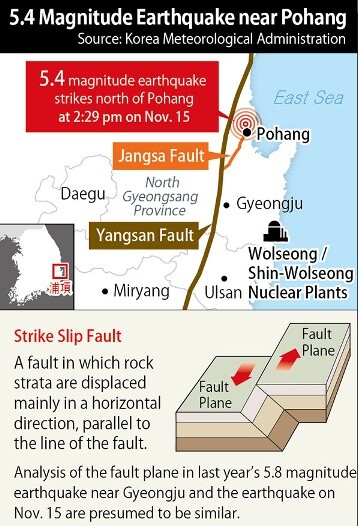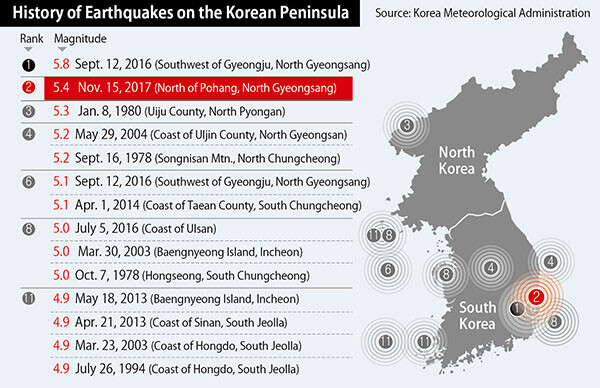hankyoreh
Links to other country sites 다른 나라 사이트 링크
[Editorial] Latest earthquake shows importance of phasing out nuclear power on Korean Peninsula

Powerful earthquakes are becoming more frequent along the southeast coastline of the Korean Peninsula. The earthquake that struck the city of Pohang on Nov. 15 had a magnitude of 5.4, while the earthquake that occurred near Gyeongju in Sept. 2016 had a magnitude of 5.8. In other words, the first and second most powerful earthquakes in Korean history occurred at an interval of one year and two months in the same area. This should be taken seriously. One can’t help worrying that this means that powerful earthquakes will occur with greater frequency and that some of them might be even more powerful still.
While the repeated earthquakes are troubling in and of themselves, such worries are compounded by the fact that this region contains the world’s greatest concentration of nuclear reactors. The nuclear power plants around the southeast coast are Wolseong, Shin-Wolseong, Kori and Shin-Kori, and there’s also the Hanul nuclear plant in Uljin. There are six nuclear reactors within a 45km radius of the epicenter of the earthquake at Pohang. The epicenter of last year’s earthquake at Gyeongju was just 27km away from the nearest nuclear reactor. This means that every earthquake is a nerve-racking experience for the millions of people who live in the area and keeps them up at night.
To be sure, Korea Hydro and Nuclear Power emphasizes that there were no problems at the nuclear reactors. Because all the nuclear reactors have been designed to withstand an earthquake with a magnitude of 6.5 (7.0 for Shin-Kori 3 and more recent reactors), there are no issues with safety, the agency says. But it would be dangerous to rule out the possibility of an earthquake that surpasses those limits. Japan presumed that an earthquake measuring 9.0 in magnitude would not occur, and then the Great East Japan Earthquake struck in 2011. Until an unprecedented amount of radiation was released in the nuclear accident at Fukushima, the Japanese nuclear authorities repeatedly asserted that nuclear power was safe.
It’s presumptuous to describe nuclear power as being “completely safe.” The same can be said for dismissing warnings about these dangers as irresponsible agitation and “urban legends about nuclear power” when powerful earthquakes keep occurring near a high concentration of nuclear reactors. It’s truly bizarre how some people counter calls for phasing out nuclear power or for taking precautions against powerful earthquakes by saying that “nothing is perfect” or by attacking critics for being “blinded by groundless beliefs.”
A catastrophe is something that bursts upon us without a word of warning. A single nuclear accident would inflict an immense amount of harm that goes beyond our imagination. It’s likely that the environment would be polluted on a huge scale, and that this would persist for a long time. It’s time to shelve the popular saying that the Korean Peninsula is safe from earthquakes. It’s time to go back to square one on earthquake countermeasures, and in particular safety measures for the nuclear reactors on the southeastern coast.

Please direct questions or comments to [english@hani.co.kr]

Editorial・opinion
![[Column] Has Korea, too, crossed the Rubicon on China? [Column] Has Korea, too, crossed the Rubicon on China?](https://flexible.img.hani.co.kr/flexible/normal/500/300/imgdb/original/2024/0419/9317135153409185.jpg) [Column] Has Korea, too, crossed the Rubicon on China?
[Column] Has Korea, too, crossed the Rubicon on China?![[Correspondent’s column] In Japan’s alliance with US, echoes of its past alliances with UK [Correspondent’s column] In Japan’s alliance with US, echoes of its past alliances with UK](https://flexible.img.hani.co.kr/flexible/normal/500/300/imgdb/original/2024/0419/2317135166563519.jpg) [Correspondent’s column] In Japan’s alliance with US, echoes of its past alliances with UK
[Correspondent’s column] In Japan’s alliance with US, echoes of its past alliances with UK- [Editorial] Does Yoon think the Korean public is wrong?
- [Editorial] As it bolsters its alliance with US, Japan must be accountable for past
- [Guest essay] Amending the Constitution is Yoon’s key to leaving office in public’s good graces
- [Editorial] 10 years on, lessons of Sewol tragedy must never be forgotten
- [Column] A death blow to Korea’s prosecutor politics
- [Correspondent’s column] The US and the end of Japanese pacifism
- [Guest essay] How Korea turned its trainee doctors into monsters
- [Guest essay] As someone who helped forge Seoul-Moscow ties, their status today troubles me
Most viewed articles
- 1[Column] The clock is ticking for Korea’s first lady
- 2Hong Se-hwa, voice for tolerance whose memoir of exile touched a chord, dies at 76
- 3After 2 months of delayed, denied medical care, Koreans worry worst may be yet to come
- 4[Column] Has Korea, too, crossed the Rubicon on China?
- 5[Correspondent’s column] In Japan’s alliance with US, echoes of its past alliances with UK
- 6US overtakes China as Korea’s top export market, prompting trade sanction jitters
- 7Samsung barricades office as unionized workers strike for better conditions
- 8All eyes on Xiaomi after it pulls off EV that Apple couldn’t
- 9More South Koreans, particularly the young, are leaving their religions
- 10John Linton, descendant of US missionaries and naturalized Korean citizen, to lead PPP’s reform effo